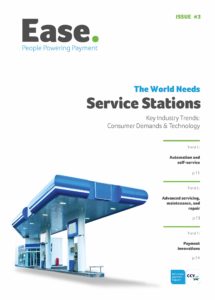Petrol and service stations are a constant presence along our roads and motorways. With over 77,000 petrol stations in Europe, this is a big industry. By working with major international fuel brands, CCV has seen first-hand that this environment is ripe for innovation.
Mobile payments at petrol stations
The process of paying with a smartphone is typically divided into two options:
- Digital smartphone wallet (NFC)
- Connected digital back-end account
The former is a type of contactless payment, using the same technology as contactless bank cards. The use of contactless payments has become commonplace across Europe, although some countries have adopted this method more readily than others. In order to cater for as many customer preferences as possible, it is mandatory that NFC technology is available at manned tills and unmanned terminals.
The latter type of mobile payment relates to a connected digital back-end account. This requires the customer to register their payment details online. In return, the merchant is provided with a token that they can use to collect future payments from the customer. This builds loyalty and ensures the customer doesn’t need to physically arrange payments when buying products or services from the brand.
Let’s agree that NFC payments are fundamental for today’s petrol stations and service stations. Indeed, offering a variety of payment methods is key to serving different customer bases: cash and contactless. In this article, we will explore the benefits of mobile payments via connected digital accounts.
Next-generation fueling
CCV has been working with well-known petrol station brands across Europe; particularly in Belgium and the Netherlands. These brands are focusing heavily on digitization. With the help of CCV and expert app engineers, they have launched an app in which customers can register an account, add their payment method, and never have to physically pay for fuel ever again!
How does this work? Put simply, it’s a token vault solution, similar to what I discussed in my recent piece about tokenised payments in EV charging. The process is as follows:
- The customer downloads the app
- The customer adds their payment details
- CCV conducts a zero cents transaction and strong customer authentication
- The payment method is enrolled
- A token is provided to the merchant to use in future payments
The back-end of the app is linked to the fuel station hardware. The next time this customer goes to refuel at the brand’s station, they will open the app and select an available pump in the front-end interface. This process will unlock the correct fuel pump at the station.
Underneath, CCV will ensure that €125.00 is reserved on the associated payment card, with a final calculation being conducted after the fuelling process is complete. If the customer doesn’t have that amount in their bank account, this will be communicated back to the pump controller and the amount of fuel will be limited to a certain achievable cost. The customer can drive away without physically paying.
We believe that modern fuelling stations should strongly consider offering tokenisation or deferred sale / authorised capture on their terminals. This makes payments very smooth and efficient for all involved.
Will this really be popular?
The success of connected digital accounts does rely on repeat custom. One-off customers will also need ad-hoc forms of payment. Not everybody will want to use this solution. With this in mind, is it overkill to build this capability? No, indeed it isn’t…
Fuel station brands have been driving loyalty for decades. It’s a competitive environment, and this means that customer retention has always been critical. There are some people who drive and refuel ad-hoc; not favouring any particular station in any particular location. But most humans are creatures of habit, especially when we have incentives to stick with one or two favoured providers.
For these people, the connected digital account is ideal. If communicated effectively, the benefits will actually encourage more customers to switch. It can be incentivised further by integrating special offers, vouchers, and offering bonus loyalty points (miles).
A tokenised payment method can be applied across the franchise services. From the coffee shop to the dry cleaners, we can move to a more seamless digitalised experience. Service stations with deli counters and sandwich bars can get customers to order and pay in advance through the app, cutting down on long queues and improving the experience for all stakeholders.
The challenges and dangers
As with all innovation, there are inherent risks and dangers. Let’s summarise the main contenders:
Eggs in one basket: We cannot assume that all service station customers will buy into this closed-loop digital account. Some might be tourists, some might be less digital-savvy, and others might not want yet another app on their home screen. To force all customers to make mobile payments would be a mistake, at least for the foreseeable future.
Security: As we wrote recently in our article about MaaS, where there is innovation there is vulnerability. Hackers will try to game the system for fraudulent purposes. When using advanced digital technology with complex software/hardware integrations, you need to have robust security in place.
Data management: Customer data is valuable to them, to you, and to the black market. Compliance with privacy laws can be cumbersome but critical. This is likely to get more challenging in upcoming years.
Behavioural quirks: People are unpredictable. Somebody will unlock a pump and decide they need to go to the toilet, leaving it open for the next driver to fill up for free. Some people might try to pay twice. Some people will allow their payment card to expire. Others might drive away with the pump plugged in. You need to be ready for all eventualities, especially when new and unfamiliar technology is involved.
Consistent uptime: Complex technology can be vulnerable to mishap. Technical collaboration is essential to ensure the system operates smoothly for the long-term. If the app-based infrastructure is temporarily out of action, you need to offer good ad-hoc payment solutions which don’t compromise the customer’s ability to collect points or other incentives.
Existential dangers
It’s important to mention the existential dangers facing the industry at this point.
The rise of electric vehicles is particularly powerful. This presents a unique set of challenges and opportunities to service station brands. In Maria’s article about the potential business models for EV charging, she highlights the need for service stations to monetise EV charging.
The rise of automated self-driving vehicles is hugely important, especially when combined with the rise of ride-sharing services. It’s feasible that our future cars will be summoned to the doorstep to take us from A to B, fully-charged, without the need for us to refuel at any point. For long journeys, recharging can be done automatically, without us getting out of the vehicle.
In general, payment systems will be integrated into the connected car – rendering the smartphone and app-based payment solution less important. These are visionary trends that must be monitored.
Interested to learn more about Trends in Petrol?
Get our free Report and discover the most powerful trends in this industry.
DOWNLOAD HERE

Summary
In Europe, consumer behaviour is fractured and payment methods are disparate. Looking to China, we see that WeChat Pay and Alipay rule the waves. But here, people of different ages in various countries prefer cash, whilst others have migrated to contactless cards. Some people are paying via their smart watch, and others want to use an app-based digital account wherever possible.
This is the complex landscape, and service stations need to cater for a huge variety of preferred payment methods. In this article, we have explored the benefits and challenges of mobile payments. It’s clear that this should be on the radar for service stations and fuel stations, with a view to building loyalty and improving the customer experience. However, it cannot be done in a half-hearted manner.
Image: Jonas Leupe on Unsplash

About the author
Anke Vandenbussche is Strategic Product Manager at CCV. After more than a decade of experience in the financial sector, Anke has built up a expertise in eCommerce entrepreneurship and online payments. As Strategic Product Manager at CCV, Anke is responsible for the strategic and commercial direction of the online payment platform, CCV Pay.
Feel free to share this article on social media:

